Development of new polymer materials. Рубрика в журнале - Nanotechnologies in Construction: A Scientific Internet-Journal
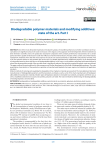
Biodegradable polymer materials and modifying additives: state of the art. Part I
Статья научная
One of the most demanded materials on the planet is plastic, the excellent performance of which contributes to the accumulation of a significant amount of waste on its basis. In this regard, a new approach to the development of these materials has been formed in scientific circles: the production of polymer composites with constant performance characteristics for a certain period and then capable of destruction under the influence of environmental factors. Analysis of the current state of the industry of polymeric materials shows that the most urgent is the use of such classical polymers as polyolefins and polyvinyl chloride. First of all, the optimal solution to this problem due to the lack of a suitable replacement for traditional polymers is the development of composites based on them with the use of biodegradable additives. In this case, a set of problems associated with waste disposal is solved: the decomposition period of the recycled waste is significantly reduced, the territories required for plastic waste are reduced. The paper outlines the preconditions for the emergence and further development of the field of biodegradable polymers. The main quantitative characteristics of the production capacities of manufactured bioplastics by types, regions and industries of application are given. Modern methods of reducing and regulating the degradation time of polymer materials are presented. The main global and domestic manufacturers of biodegradable polymers and their products are listed, as well as a list of the main manufacturers of biodegradable additives for polymeric materials. Modern types of bioplastics based on renewable raw materials, composites with their use, as well as modified materials from natural and synthetic polymers are listed. The main methods for determining the biodegradability of existing bioplastics are described.
Бесплатно
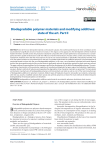
Biodegradable polymer materials and modifying additives: state of the art. Part II
Статья научная
One of the most demanded materials on the planet is plastic, the excellent performance of which contributes to the accumulationof a significant amount of waste on its basis. In this regard, a new approach to the development of these materials hasbeen formed in scientific circles: the production of polymer composites with constant performance characteristics for a certainperiod and then capable of destruction under the influence of environmental factors. Analysis of the current state of the industry of polymeric materials shows that the most urgent is the use of such classical polymers as polyolefins and polyvinyl chloride. First of all, the optimal solution to this problem due to the lack of a suitable replacement for traditional polymers is the development of composites based on them with the use of biodegradable additives. In this case, a set of problems associated with waste disposal issolved: the decomposition period of the recycled waste is significantly reduced, the territories required for plastic waste are reduced. The paper outlines the preconditions for the emergence and further development of the field of biodegradable polymers. The mainquantitative characteristics of the production capacities of manufactured bioplastics by types, regions and industries of applicationare given. Modern methods of reducing and regulating the degradation time of polymer materials are presented. The main global and domestic manufacturers of biodegradable polymers and their products are listed, as well as a list of the main manufacturers of biodegradable additives for polymeric materials. Modern types of bioplastics based on renewable raw materials, composites with their use, aswell as modified materials from natural and synthetic polymers are listed. The main methods for determining the biodegradability of existing bioplastics are described.
Бесплатно

Biodegradable polymer materials and modifying additives: state of the art. Part III
Статья научная
One of the most demanded materials on the planet is plastic, the excellent performance of which contributes to the accumulationof a significant amount of waste on its basis. In this regard, a new approach to the development of these materials hasbeen formed in scientific circles: the production of polymer composites with constant performance characteristics for a certainperiod and then capable of destruction under the influence of environmental factors. Analysis of the current state of the industry of polymeric materials shows that the most urgent is the use of such classical polymers as polyolefins and polyvinyl chloride. First of all, the optimal solution to this problem due to the lack of a suitable replacement for traditional polymers is the development of composites based on them with the use of biodegradable additives. In this case, a set of problems associated with waste disposal issolved: the decomposition period of the recycled waste is significantly reduced, the territories required for plastic waste are reduced. The paper outlines the preconditions for the emergence and further development of the field of biodegradable polymers. The mainquantitative characteristics of the production capacities of manufactured bioplastics by types, regions and industries of applicationare given. Modern methods of reducing and regulating the degradation time of polymer materials are presented. The main global and domestic manufacturers of biodegradable polymers and their products are listed, as well as a list of the main manufacturers of biodegradable additives for polymeric materials. Modern types of bioplastics based on renewable raw materials, composites with their use, aswell as modified materials from natural and synthetic polymers are listed. The main methods for determining the biodegradability of existing bioplastics are described.
Бесплатно
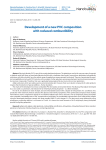
Development of a new PVC composition with reduced combustibility
Статья научная
Polyvinyl chloride (PVC) is one of the mostly plasticized polymers. The plasticizers used in this case are esters of aromatic or aliphatic acids with linear or branched aliphatic alcohols with a moderate chain length. Among them, phthalates (orthophthalic acid esters with fatty alcohols) have the widest range of applications among aromatic acid esters. They are characterized by excellent compatibility not only with PVC, but also with a number of other polymers, possess good physical and mechanical properties, but are toxic compounds. Therefore, their use is gradually being replaced by low-toxic and non-toxic plasticizers. Adipic acid esters which are widely used are environmentally safe. However, their use in plastic compounds for cable products requires the introduction of special additives – flame retardants. The results of the development of a low combustible PVC formulation are described herein. The dibutoxyethyl adipate developed by us was used as a plasticizer, and industrial di-(2-ethylhexyl) phenyl phosphate – as a flame retardant. First of all, we obtained an ester of adipic acid and ethoxylated butanol with a degree of ethoxylation of 5. Conditions of its production with maximum yield are selected. The physical and chemical properties of the synthesized compound were studied. Formulations of PVC compositions based on the obtained adipate with various amounts of di-(2-ethylhexyl) phenyl phosphate were compiled. Flammability tests of PVC compounds are presented. The combustible characteristics of the cable plastic samples using the developed plasticizers comply with state standard 5960-72 with changes 3-9. The best results were obtained by using phosphorus-containing additive in an amount of 3 wt%. It is shown that small amounts of di-(2-ethylhexyl) phenyl phosphate provide fire-fighting properties.
Бесплатно
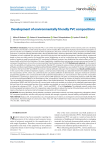
Development of environmentally friendly PVC compositions
Статья научная
Introduction. Polyvinyl chloride (PVC) is one of the most important polymers in the economy. Due to its versatility, this material is now found in a wide variety of products used in everyday life. A wide range of physical and mechanical properties is given to it by the use of additives, the main of which are plasticizers. The most common in terms of consumption are orthophthalic acid esters, in particular, dibutyl phthalate (DBP), dioctyl phthalate (DOP), diisononyl phthalate (DINP), diisodecyl phthalate (DIDP). Phthalates are well combined with polymers, give them high physical and mechanical properties, therefore plastic compounds based on them are widely used in the construction sector, engineering, as well as in agriculture and in everyday life. Numerous studies of products made from plasticized PVC, conducted in different countries, have established the adverse effects of DOP on human health, which led to the limitation of its areas of application. Legislative bans and growing consumer pressure are forcing PVC compound manufacturers to look for an environmentally friendly replacement for DOP. Methods and materials. In this research work, the possibility of creating more environmentally friendly PVC compounds using a mixture of plasticizers: industrial dioctyl phthalate and diisononyl phthalate and dibutoxyethyl phthalate (DBOEP) developed by us was studied. The choice of the plasticizers is based on the fact that DINP and DBOEP, in contrast to dioctyl phthalate, belong to the 3rd hazard class. Results and discussion. In the course of the correlation-regression analysis, a close functional relationship was obtained between the additives used and the characteristics of PVC, which was confirmed by the calculated coefficient of determination. Using the method of nonlinear programming applied to the constructed third-order polynomial dependencies, it was found that in the basic PVC composition formulation it is promising to replace up to 25 wt.h. DOP on DINP plasticizer. The joint use of industrial plasticizers DOP and DINP, as well as the developed DBOEP in the formulation of PVC compositions, indicates an increase in plasticity and manufacturability. This can probably be explained by the synergistic effect of the studied plasticizers. The dependence of the properties and content of plasticizers DBOEP and DINP in the form of a second-order surface was studied on the basis of the obtained experimental data, the level lines of the constructed function of two variables were studied, as a result of which it was found that the greatest effect is achieved at a dosage of: DOP – 25 wt.h., DINP – 5 wt.h. and DBOEF – 20 wt.h. Conclusion. The obtained research results show that the proposed formulation of the PVC composition makes it possible to reduce the toxicity of the plasticizers used by 50 % and improve the physical, mechanical and technological characteristics of the compounds.
Бесплатно
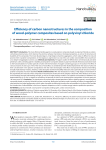
Статья
Introduction. The most effective binding agents in wood-polymer composites based on polyvinyl chloride are carboncontaining nanostructures, which improve the electrical, physical-mechanical, rheological properties, as well as the structure and durability of the composites. Their main disadvantage is a high degree of particle aggregation, which makes it difficult to mix and process them in polymer compositions. In this regard, an urgent task is to search for such carbon nanomodifiers that would have a low degree of aggregation and low cost. Methods and materials. The paper studies the effectiveness of mechanically activated petroleum cokes as binding agents in building wood-polymer composites based on polyvinyl chloride. Mechanical activation leads to the functionalization of carbon particles of coke with the formation of oxygen-containing groups on the surface. The effect of various amounts of coke (up to 10% of the mass of wood flour) is considered and the relationship between the nature of coke and their concentration in the polymer compositions with the main technological (melt flow) and operational (tensile and bending strength, high elasticity modulus, hardness, water absorption and thermal stability) indicators and supramolecular structure of woodpolymer composites has been identified. Results and discussion. With the introduction of cokes, a high degree of orientation of the supramolecular structures of the composites in the direction of extrusion of the samples is observed, which leads to an increase in the breaking strength and bending strength, as well as the high elasticity modulus. The optimal concentration of additives was determined from 0.1 to 5%. In relation to wood flour, the amount of which in the wood-polymer composition is 50 mass parts per 100 mass parts PVC. Conclusion. The introduction of mechanically activated petroleum cokes as binding agents in wood-polymer composites based on polyvinyl chloride has been carried out. Mechanical activation made it possible to reduce the aggregation of coke particles into larger agglomerates, which makes it possible to efficiently introduce the nanomodifier in dry form and to exclude the introduction of nanomodifier in the form of aqueous dispersions, which is a rather energy-intensive production operation.
Бесплатно
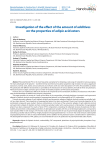
Investigation of the effect of the amount of additives on the properties of adipic acid esters
Статья научная
Polyvinylchloride (PVC) is the most frequently used polymer for obtaining a wide range of materials for various purposes. The main advantages of the polymer – excellent thermal and electrical insulation properties, high resistance to various aggressive substances, namely: acids, alkalis, various lubricants; lack of taste, smell; low water absorption (0.4–0.6%). The possibility to obtain PVC-plasticates with different characteristics is provided by the introduction of various additives, the bulk of which are plasticizers. Plasticizers based on adipic acid esters give a number of valuable properties to PVC-based compositions. However, the use of plasticizers affects the resistance of compounds to the combustion, therefore, the substances which eliminate this disadvantage are added in the polymer composition. This paper presents the results of a study of the effect of the composition of mixed plasticizers (symmetric and asymmetric adipates of aliphatic alcohols and phosphate of oxypropylated phenol) on the flammability of PVC composition. Primarily symmetric adipate of cyclic aliphatic alcohols and asymmetric adipate of aliphatic alcohols containing cycloalkyl radical have been derived. Then phosphate of oxypropylated phenol has been synthesized. Physical and chemical properties of the synthesized compounds were studied. Mixtures of plasticizers on the basis of the symmetric adipate of cyclic aliphatic alcohols and asymmetric adipate of aliphatic alcohols containing cycloalkyl radical with varying amounts of phosphate of oxypropylated phenol have been composed. The results of tests of PVC compositions containing the obtained mixtures of plasticizers for flammability are presented. Combustibility parameters of cable plasticate samples with the use of developed plasticizers correspond to state standard 5960-72 with changes 3-9. The best results were achieved with the use of asymmetrical adipate of aliphatic alcohols containing cycloalkyl radical and 4% by weight phosphate of oxypropylated phenol. It is shown that small amounts of phosphate oxypropylated phenol are able to reduce flammability, further addition of this plasticizer leads to a deterioration in performance. The developed formulations of PVC plastics are recommended for use in the production of polyvinylchloride cable sheaths.
Бесплатно
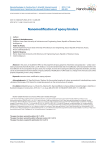
Nanomodification of epoxy binders
Статья научная
In this work, we studied the effect on the properties of epoxy polymers of domestic nanoproduction – carbon nanotubes produced by NanoTechCenter LLC (RF, Tambov). It has been determined that the modification of functionalized CNTs is the most effective in the composition of epoxy resins, for example, in terms of increasing the adhesive properties of binders, and they can be recommended in the formulations of epoxy adhesives. Modification of CNTs leads to a change in the microstructure of the polymer, depending on the curing conditions.
Бесплатно
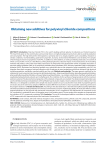
Obtaining new additives for polyvinyl chloride compositions
Статья научная
Introduction. Polyvinyl chloride (PVC) is the world's leading synthetic polymer in industrial use. Products based on PVC have firmly taken on the world market, and currently there is no highly developed country that is able to avoid its production and consumption. The high demand for thermoplastics is primarily due to its unique properties such as durability, resistance to climatic conditions, low flammability, good barrier properties, economy, environmental friendliness and versatility. The complex of technological and service properties of soft PVC, in addition to other additives, is mainly provided by plasticizers, the content of which can reach 50% or more. It is the efficiency of the plasticizing that has a decisive impact on the characteristics in the resulting materials and products. One of the most widely used classes of compounds in the plasticization of PVC are phthalic acid esters, in particular, dibutyl phthalate (DBP), di-(2-ethylhexyl)-phthalate (dioctyl phthalate, DOP), diisononyl phthalate (DINP) and diisodecyl phthalate (DIDP). Phthalates have found the greatest use as plasticizers due to their properties: good compatibility with PVC, low migration from plastic compound, minimal interaction with the polymer at room temperature, good frost resistance, high electrical insulating properties, availability, manufacturability and low cost. Methods and materials. The paper presents methods for the obtaining of novel symmetrical and asymmetric phthalate plasticizers: dibenzoxyethyl phthalates, benzylbenzoxyethyl phthalates, phenoxyethylbenzoxyethyl phthalates, ethoxyoctylbenzoxyethyl phthalates – by catalytic esterification of phthalic anhydride with oxyethylated phenylcarbinols, phenols and 2-ethylhexanols. The conditions for the synthesis of target products with the maximum yield were selected. The physicochemical properties of the obtained compounds were studied. The obtained experimental data were used to identify promising novel plasticizers of the phthalate type by cluster analysis. Cluster analysis for decision making is the most effective, as it is designed to combine some samples into classes (clusters) in such a way that the most similar in properties get into one cluster, but at the same time, samples of different clusters differ from each other as much as possible. Clustering carried out in the program Statistica 10. Results and discussion. According to the data obtained, it is found that benzylbenzoxyethyl phthalates and ethoxyoctylbenzoxyethyl phthalates have the best characteristics in terms of plasticizing ability. We study the influence of the selected plasticizers on the physical and mechanical characteristics of PVC compositions The effectiveness of compounds in the PVC composition is evaluated in terms of “elongation stress” and “breaking stress”. The test results of the samples are compared with the indicators of PVC compounds containing DBP. Conclusion. The use of the developed additives contributes to the production of PVC compounds with improved physical and mechanical characteristics.
Бесплатно
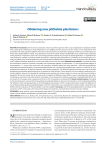
Obtaining new phthalate plasticizers
Статья научная
Introduction. The increase in production volumes and the expansion of the scope of application of polyvinyl chloride (PVC) compounds contributes to the development of new additives and the attraction of new sources of raw materials for their production. The most important additives necessary for processing PVC are plasticizers. Plasticizers market is one of the largest segments of the global additives market. Since plasticizers are the most simple, cheap and affordable way to modify various properties of the polymeric compositions, their role in processing polymeric materials has recently increased significantly. In application the ester plasticizers, capable to plasticize almost all polymers, especially polyvinylchloride are considered as the most practical. Currently, the industry has mastered production of more than three hundred brands of plasticizers, most of which are esters of phthalic acid. Traditional phthalate plasticizers are the most widely used all over the world. Materials and methods. The paper describes the esterification reactions of phthalic anhydride with oxyethylated (degree of oxyethylation 1.2) and oxypropylated (degree of oxypropelation 1.1) cresols. New symmetric and asymmetric phthalate plasticizers were obtained – dikresoxycresylphthalate, butoxyethylcreoxyethylphthalate, cresylcresoxyethylphthalate and cresylcresoxypropylphthalate, optimum conditions for their preparationare picked up, studied their physical and chemical properties. The obtained experimental data were used to identify promising new phthalate-type plasticizers by the method of cluster analysis. Cluster analysis is the most effective method for solving this problem, because it is intended for combining some samples into classes (clusters) in such a way that the most similar in properties fall into one cluster, but at the same time the samples of different clusters differ as much as possible from each other. Clustering was carried out using the Statistica 10 program. Since at present the reference plasticizer is dioctylphthalate (DOP), the test results of the samples were compared with those of PVC compositions containing DOP. Results and discussions. According to the data obtained, it was found that butoxyethylcreoxyethyl phthalate has the best characteristics in terms of plasticizing ability. The influence of the selected plasticizer on the technological characteristics of PVC-compounds has been studied. The efficiency of the synthesized butoxyethylcreoxyethylphthalate in the PVC composition was evaluated by the indicator (index) of melt flow rate (MFR) and by the indicators of “thermal stability” and “color stability”. Conclusion. Use of the developed additive contributes to the production of PVC compounds with improved rheological characteristics, increased heat resistance and color stability.
Бесплатно
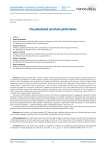
Oxyalkylated alcohols phthalates
Статья научная
Polyvinyl chloride (PVC) is used to obtain a wide range of materials for various purposes. High demand of PVC is explained by possibility to modify polyvinyl chloride and produce broad range of materials with improved properties as well as to have cost efficient ratio: productivity, available raw materials, saving of natural resources. However, under normal temperature polyvinyl chloride is brittle and inelastic, that limits the fields of PVC application. The production of basic PVC compositions is impossible without plasticizers – low-molecular compounds that allow direct regulating physical and mechanical properties of polymer. Production of plasticizers became one of the most important branch of petrochemical industry. Recently, however, the range and production of plasticizers have drastically decreased due to the increased cost, which reduced the competitiveness of plasticized PVC products. Therefore, the expansion of plasticizer variety for PVC is a strategic task of great practical significance. The present work describes synthesis methods of esters on the basis of oxyalkylated alcohols suggested as polyvinyl chloride plasticizers. Physico-chemical properties of synthesized compounds were studied. Conditions for their production with maximum outcome were selected. The results of experiments in which obtained compounds were tested as additives in the plasticization of PVC showed that the obtained samples of cable plastic, adhesive PVC tapes and multi-layered polyvinyl chloride linoleum satisfy all the technical requirements by the main indicators: cable plastic compound – GOST 5960-72 with amendment 1-9; a PVC adhesive tape – Technical Conditions – 2245-001-00203312-2003; multilayered linoleum – GOST 7251-77. According to the experimental results, phthalates of oxyalkylated alcohols possess rather high efficiency as plasticizers of polyvinyl chloride and are recommended for use in the above-mentioned industrial PVC recipes.
Бесплатно
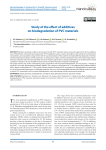
Study of the effect of additives on biodegradation of PVC materials
Статья научная
Modern operating conditions of polyvinyl chloride (PVC) materials impose increased requirements for the additives used. Intensification of processing and expansion of PVC application areas, as well as providing a wide variety of its performance characteristics, are associated to a large extent with the successful solution of the problem of creating effective plasticizers. Therefore, when developing formulations of PVC plasticates, it is important to obtain and select plasticizers that meet modern high requirements for operation and environmental safety. One of the modern approaches to creating materials that can be destroyed in natural conditions is based on the use of additives that increase the ability of polymer materials to biodegrade. This paper presents the results of developing a PVC composition with increased biodegradation. For this purpose, a mixture of plasticizers was used: dibutoxyethyl phthalate (DBOEP) with a degree of ethoxylation of 1.5 and dibutoxyethyl adipate (DBOEA) with a degree of ethoxylation of 1.5. The results of testing samples of obtained PVC compositions for biodegradation are presented. It is shown that partial replacement of a phthalate plasticizer with a non-toxic biodegradable dibutoxyethyl adipate makes it possible to obtain PVC compositions with increased biodegradation, while maintaining excellent performance properties.
Бесплатно
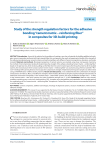
Статья научная
Introduction. As part of the solution for the problem of creating a new class of materials for building additive technologies, cement composites reinforced with high-strength fiber, this work presents the results of experimental studies of the strength of the adhesive bonding between cement matrices and reinforcing fibers with different chemical compositions, diameters, and tensile strength. Materials and methods. Rheological properties of cement systems were studied using shear and squeeze rheometry, the method of micromechanical testing for determining the strength of the adhesive bonding “cement matrix – reinforcing fiber” based on the pull-out test, which involves pulling out the fiber from the cement matrix layer; after the pull-out test for all the studied systems, the microstructure of the contact surface “cement matrix – reinforcing fiber” was assessed using a Thermo Scientific™ Phenom ™ Desktop SEM scanning electron microscope; the compressive strength of hardened cement paste-samples was determined using an INSTRON Sates 1500HDS testing machine. Results and discussions. It was established that the combination of strength characteristics of matrices, fibers, and adhesive strength at their interface allowed securing the required strength characteristics of reinforced construction composites. In the “cement matrix – carbon fiber” systems, the value of adhesive strength was 9 – 11 MPa; in the “cement matrix – steel wire” systems, the value of adhesive strength was 3 – 4 MPa. Conclusions. Matrices with viscosity modifiers containing nano- and micro-sized particles of SiO2 (complex nano-sized additive and metakaolin) are reasonable options for combinations of the “cement matrix – reinforcing fiber” components. Carbon fiber and steel wire are recommended to be used as reinforcing fibers.
Бесплатно
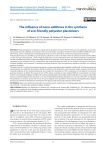
The influence of nano-additives in the synthesis of eco-friendly polyester plasticizers
Статья научная
Plasticized polymer materials are widely used in all spheres of human life. The most common plasticizers are aromatic compounds-esters of o-phthalic acid. However, their use was limited in accordance with the EU Directive REACH (2009) due to possible toxicity, which contributed to the development of new non-toxic alternatives, which include polyester plasticizers. Polyester plasticizers are classified as special purpose plasticizers. Due to the wide variety of starting materials and the ability to vary the size of the molecule, a wide range of plasticizers can be synthesized. These are mainly polyesters of polyatomic alcohols esterified with dibasic acids and modified with monocarboxylic acid or aliphatic alcohol. Polyesters-based plasticizers contribute to the production of PVC compositions with improved properties such as low volatility, resistance to extraction, excellent flexibility, wear resistance, UV resistance and heat resistance. Also, such plasticizers exhibit an excellent non-sweating property of plastics. This paper describes a method for preparing a polyester compound propylene glycol adipate modified with cyclohexanecarboxylic acid, proposed as a plasticizer of polyvinyl chloride. Conditions of its production with maximum output are given. Physical and chemical properties of the resulting compound were studied. The formulation of PVC-composition on the basis of the received polyester plasticizer is offered. The results of tests of PVC plastic according to state standard 5960-72 are presented. It is shown that the use of propylene adipate modified with cyclohexanecarboxylic acid provides a plasticizing efficiency as high as DOP, while having a reduced migration. This fact allows us to use the developed polyester plasticizer as a non-toxic alternative to industrial PVC plasticizers. It has been found that the use of calcium adipate nano quantities in the production of propylene glycol adipate increases the yield of the desired ester and improves the physical and mechanical properties of PVC plastic.
Бесплатно

